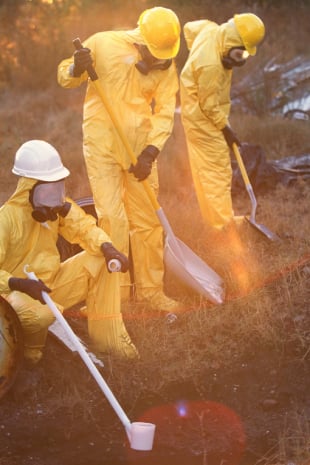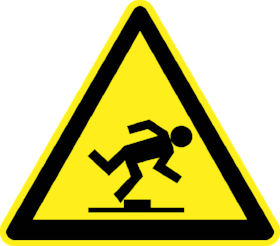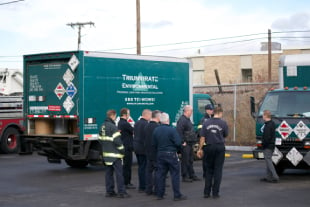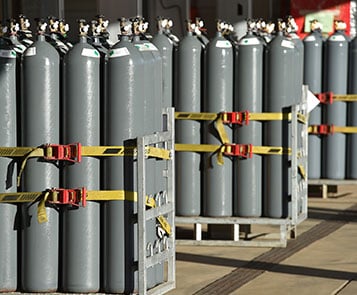Q&A Series: An Expert's Take on Preparing for an EH&S Emergency
Are you prepared for an emergency response (ER) situation, such as a chemical spill, unknown odor, water/sewer line break, oil spill, and more? Being prepared and reacting swiftly to assembly your ER team can help to prevent further harm. I recently delivered a webinar on this topic and provided answers to some of the most frequently asked questions regarding ER situations. Read on to see a portion of the questions and answers, and be sure to watch our webinar to hear the rest of the Q&A!Is ER only governed under 1910.38?
1910.38 is actually your emergency action plan. So, that's going to be your plan in the event something was to happen. When you talk about emergency response situations, in the case for an emergency action plan, it's not just chemical, it's going to be everything - hurricanes, tornadoes, anything that can affect your facility from an emergency situation.
When talking about emergency response in response to chemical spills, you're also going to be covered under HAZWOPER, which is 1910.120 and 1926.65, the OSHA side for ERs. Beyond 1910.38, when you get into the HAZWOPER, that's when you get into the levels of training for the people who are out there to respond. Under HAZWOPER, you will have somebody with awareness training, who is able to discover a spill and make a phone call. The next level is operations, which is someone who can make defensive measures. Next, are the technicians, who have 24 hour training and can do offensive measures. There are also specialists, who are the same level as technicians, but they have specific chemical training for a specific facility. The highest level is your instant commander.
There's also a portion if you're dealing with chemicals that falls under RCRA regulations (40 CFR) when it comes to having an incident commander, or if you're a large quantity generator, you could have a contingency plan. That person under the RCRA regulations is going to need to be able to make decisions for your facility.
What constitutes as an emergency spill vs. a non-emergency spill?
An emergency spill is considered anything that is:
- Immediately dangerous to life and health (IDLH), or
- An uncontrolled release of a hazardous substance to the environment.
The following are not considered emergency spills:
- An incidental spill - you as a company decide what's incidental and write that into your plan.
- A spill clean up; if somebody spills something in secondary containment.
- A small volume spill that won't get released to the environment, is not an IDLH, and is contained within an area.
Who should take the lead when responding to an emergency?
If you have an emergency action plan or a contingency plan, you're going to identify who your incident commanders and leads are. If you are on call rotation, that should be the person taking the lead if something was to happen. That person will know your internal protocols. They should also be someone who can make monetary decisions for your company. It has come up in the past where a company has somebody internally who takes control of the emergency, and then the fire department shows up and takes control over the situation. The problem here, is they will take over for a short amount of time until they can clear the area, and then they will hand it back to you or hand it off to your responding contractor. Therefore, even if the fire department takes it, you should still have an internal person designated as either your instant commander or your spill lead. Just in case, you should always have at least one back up lead, or even two/three to be safe.
What level of emergency response team is required at larger and smaller sites?
Large site vs. small site comes down to what type of emergency you could have. It also depends on whether or not the company wants to invest in having an internal team. Some companies have a full-blown response team with EMTs on the site and about 40 people on the ER team. Other large sites I've seen with only about four people, and they decide not to have their own internal response team. It comes down to what your company wants to take on as a liability and training-wise. When you look at the size you may need in your facility, some factors that should be taken into account are:
- Types of chemicals on site
- Type of environment and weather patterns (tornadoes, hurricanes, etc.)
If you are just going to have incident commanders, I would suggest having at least 2-4 people so you can be on a rotation. If it gets into the true ER and you're talking chemicals, you'll need to look at the titles that are required under OSHA. So, if you have a real response, you need at least one incident commander and you'll also need a safety officer to control the situation. The decision on how many people you want on your team should be made internally.
Watch Our Webinar
If you would like to see the rest of the recorded live Q&A, please click here. You will find answers to other pressing ER questions, such as:
- Assuming there's an emergency, who do I call and when?
- What advice do you give for a rural university to prepare for chemical spills (our ER contractor is four hours away)?
- What information should be provided to a responding contractor?
- What level of training is HAZWOPER 40 considered? Awareness, operations, technician, specialist, or incident commander?
- What are the pros and cons of using an in-house response team vs. outside help?
- Does it have to be one or the other, or can there be a hybrid approach? Does it depend on the facility?If our internal team is only doing defensive measures, do we have to have a medical program?
- Is an in-house response team for mineral oil spills required to have HAZWOPER training (24 hour)?
- Should emergency response plans be separated by event?
- What elements should be included for effective table top and mock spill exercises?
- How long do you typically wait between running a table top drill and a live drill?
- Is it better to focus on rare worst-case scenarios or those that are more likely to occur?
- Is there a template contingency plan or some sort of quick reference guide that has to be submitted to local authorities when an LQG has an emergency?
- In the absence of a campus-wide EH&S department, what length do you recommend training laboratory staff to help other departments on campus?







